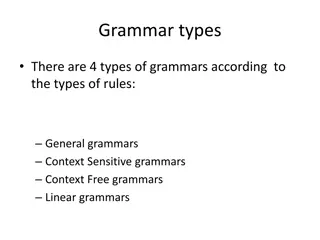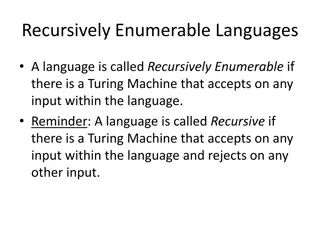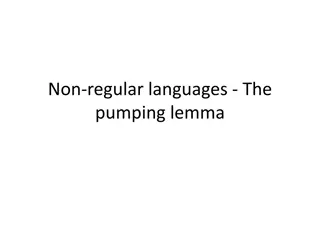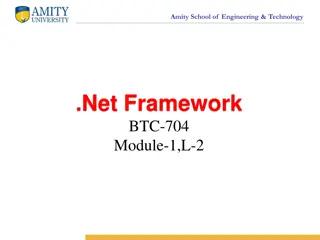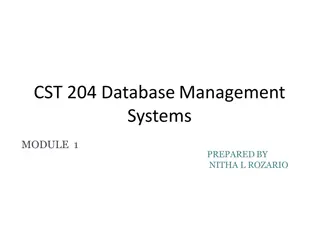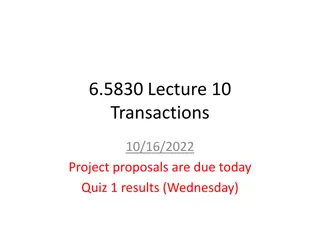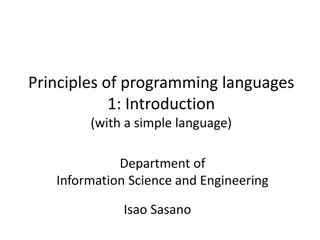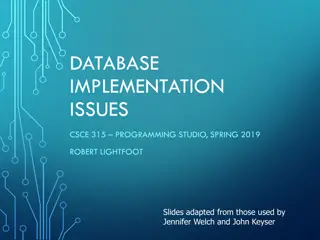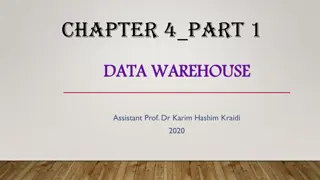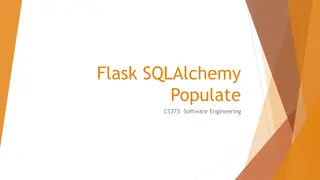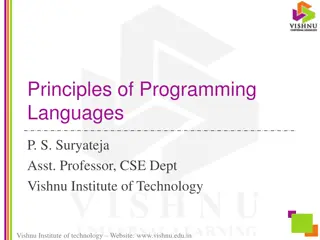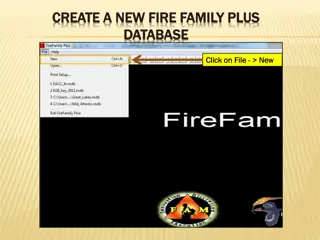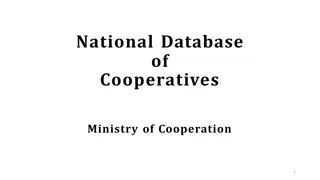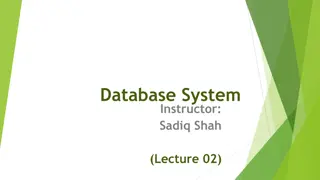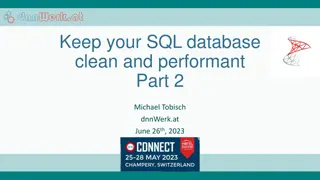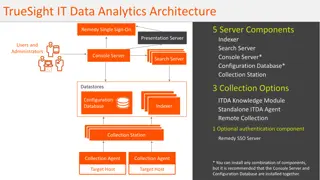Overview of Database Systems Architecture and Languages
A database system is essential for storing and managing an organization's data. The architecture includes components like file manager, database manager, and query processor. Additionally, DML and DDL compilers play crucial roles in handling data manipulation and definition tasks. Various data structures like data files, data dictionary, and indices are needed for efficient system implementation. Database managers, administrators, and users have distinct roles in accessing and utilizing the database system.
Download Presentation

Please find below an Image/Link to download the presentation.
The content on the website is provided AS IS for your information and personal use only. It may not be sold, licensed, or shared on other websites without obtaining consent from the author. Download presentation by click this link. If you encounter any issues during the download, it is possible that the publisher has removed the file from their server.
E N D
Presentation Transcript
IDHAYA COLLEGE FOR WOMEN KUMBAKONAM Semester Subject Subject Code : : : IV Database Systems 16SCCCA4 Topic : 1. Database System Architecture 2. Database Languages 3. Relational Algebra Operations 4. Functional Dependencies Faculty Name : Dr.K.Bhuvaneswari, M.C.A., M.Phil., Ph.D. Assistant Professor, Department of Computer Applications, Idhaya College for Women, Kumbakonam.
DATABASE SYSTEM ARCHITECTURE A database can be termed as a repository of data. A collection of actual data which constitutes the information regarding an organisation is stored in a database. Database systems are partitioned into modules for different functions. Some functions (e.g. file systems) may be provided by the operating system.
Components Include : File manager: manages allocation of disk space and data structures used to represent information on disk. Database manager: The interface between low-level data and application programs and queries. Query processor: translates statements in a query language into low-level instructions the database manager understands.
DML precompiler : converts DML statements embedded in an application program to normal procedure calls in a host language. The precompiler interacts with the query processor. DDL compiler: converts DDL statements to a set of tables containing metadata stored in a data dictionary.
In addition, several data structures are required for physical system implementation: Data files: store the database itself. Data dictionary: stores information about the structure of the database. Great emphasis should be placed on developing a good design and efficient implementation of the dictionary. Indices: provide fast access to data items holding particular values.
Database manager is a program module which provides the interface between the low-level data stored in the database and the application programs Database administrator is a person having central control over data Database user is a person who access the database at various level.
DATABASE LANGUAGES As a language is required to understand any thing, similarly to create or manipulate a database we need to learn a language .Database language is divided into mainly 2 parts :- 1.DDL(Data definition language) 2.DML(Data Manipulation language)
Data Definition Language (DDL) Used to specify a database scheme as a set of definitions expressed in a DDL 1. DDL statements are compiled, resulting in a set of tables stored in a special file called a data dictionary or data directory. 2. 2. The data directory contains metadata (data about data)
3. The storage structure and access methods used by the database system are specified by a set of definitions in a special type of DDL called a data storage and definition language 4. basic idea: hide implementation details of the database schemes from the users
Data Manipulation Language (DML) 1. Data Manipulation is: retrieval of information from the database insertion of new information into the database deletion of information in the database modification of information in the database
2. A DML is a language which enables users to access and manipulate data. The goal is to provide efficient human interaction with the system. 3. There are two types of DML: procedural: the user specifies what data is needed and how to get it nonprocedural: the user only specifies what data is needed
Easier for user May not generate code as efficient as that produced by procedural languages 4. A query language is a portion of a DML involving information retrieval only. The terms DML and query language are often used synonymously
RELATIONAL ALGEBRA OPERATIONS An operation is fundamental if it cannot be expressed with other operations. The relational algebra has six fundamental operations: Select (unary) Project (unary) Rename (unary) Cartesian product (binary) Union (binary) Set-difference (binary)
Select Operation It selects tuples that satisfy the given predicate from a relation. Notation pr stands for selection predicate r stands for relation p is prepositional logic formula which may use connectors like and, or, and not. These terms may use relational operators like =, , , < , >, .
Eg. subject= "database" and price = 900"(Books) Output Selects tuples from books where subject is 'database' and 'price' is 900. subject = "database" and price = 500" or year > "2012"(Books) Output Selects tuples from books where subject is 'database' and 'price' is 500 or those books published after 2012.
Project Operation It projects columns that satisfy a given predicate. Notation A1 , A2 , An r Where A1, A2 , An are attribute names of relation r. Duplicate rows are automatically eliminated, as relation is a set. subject, author (Books) Selects and projects columns named as subject and author from the relation Books.
Union Operation It performs binary union between two given relations r s = { t | t r or t s} and is defined as Notation r U s Where r and s are either database relations or relation result set temporary relation. For a union operation to be valid, the following conditions must hold r, and s must have the same number of attributes. Attribute domains must be compatible. Duplicate tuples are automatically eliminated.
author (Books) author (Articles) Output Projects the names of the authors who have either written a book or an article or both. Set Difference The result of set difference operation is tuples, which are present in one relation but are not in the second relation. Notation r s Finds all the tuples that are present in r but not in s. author (Books) author (Articles) Output Provides the name of authors who have written books but not articles.
Cartesian Product Combines information of two different relations into one. Notation r s Where r and s are relations and their output will be defined as r s = { q t | q r and t s} author = authors'(Books Articles) Output Yields a relation, which shows all the books and articles written by authors
Rename Operation The results of relational algebra are also relations but without any name. The rename operation allows us to rename the output relation. 'rename' operation is denoted with small Greek letter rho . Notation x E Where the result of expression E is saved with name of x.
FUNCTIONAL DEPENDENCY In relational database theory, a functional dependency is a constraint between two sets of attributes in a relation from a database. In other words, functional dependency is a constraint that describes the relationship between attributes in a relation. ... Y is a function of X.
Types of Functional Dependencies 1. Trivial functional dependency The dependency of an attribute on a set of attributes is known as trivial functional dependency if the set of attributes includes that attribute. Symbolically: A ->B is trivial functional dependency if B is a subset of A. The following dependencies are also trivial: A->A & B->B
2. non-trivial functional dependency If a functional dependency X->Y holds true where Y is not a subset of X then this dependency is called non trivial Functional dependency. Eg. An employee table with three attributes: emp_id, emp_name, emp_address. Functional dependencies are non-trivial: emp_id -> emp_name (emp_name is not a subset of emp_id) emp_id -> emp_address (emp_address is not a subset emp_id) of
Completely non trivial FD: If a FD X->Y holds true where X intersection Y is null then this dependency is said to be completely non trivial function dependency. 3.Multivalued dependency: Multivalued dependency occurs when there are more than one independent multivalued attributes in a table. Eg.: Consider a bike manufacture company, which produces two colors (Black and white) in each model every year.
Bike_model M1001 M1002 M1002 M1020 M2010 M2010 Manuf_year 2010 2011 2011 2012 2013 2013 Colour Red Black Red Black Red Black Here columns manuf_year and color are independent of each other and dependent on bike_model. In this case these two columns are said to be multivalued dependent on bike_model. These dependencies can be represented like this:
bike_model ->> manuf_year bike_model ->> color 4.Transitive dependency A functional dependency is said to be transitive if it is indirectly formed by two functional dependencies. For e.g. X -> Z is a transitive dependency if the following three functional dependencies hold true: X->Y Y does not ->X Y->Z A transitive dependency can only occur in a relation of three of more attributes.










